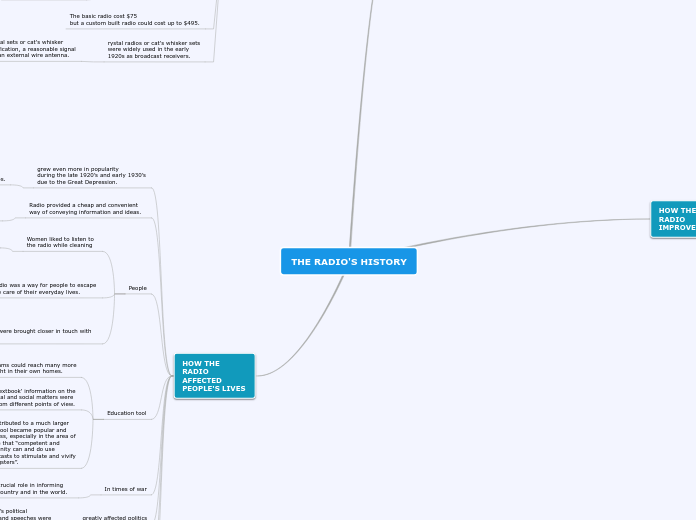THE RADIO'S HISTORY
HOW THE RADIO AFFECTED PEOPLE'S LIVES
Radios have helped to provide communication as well as entertainment throughout the society of many cultures.
radio remains one of the best communication tools for the rural poor.
greatly affected politics
In the 1920’s political campaigns and speeches were broadcast over the radio.
In times of war
During World War ΙΙ radio played a crucial role in informing citizens about the situation in their country and in the world.
Education tool
Radio allowed information to be distributed to a much larger audience. Radio as an educational tool became popular and many studies proved its effectiveness, especially in the area of distance education. It was the hope that “competent and imaginative teachers in any community can and do use teaching aids such as school broadcasts to stimulate and vivify the classroom experiences of youngsters”.
spreading 'textbook' information on the radio, political and social matters were discussed from different points of view.
radio programs could reach many more people – right in their own homes.
People
People living in rural areas were brought closer in touch with the cities of the nation.
Radio was a way for people to escape the care of their everyday lives.
regardless of where they were located, they could tune in to listen to news, sports broadcasts, comedy shows, dramas, live music and political addresses.
From news to music to sports and community announcements.
Women liked to listen to the radio while cleaning
but using the earphones
Radio provided a cheap and convenient way of conveying information and ideas.
Radio has changed the way we communicate with each other, how we share and promote our thoughts, opinions and creations
grew even more in popularity during the late 1920’s and early 1930’s due to the Great Depression.
Between 1923 and 1930, 60 percent of American families purchased radios.
RADIO IN 1920
CRYSTAL RADIO
rystal radios or cat's whisker sets were widely used in the early 1920s as broadcast receivers.
Although these early crystal sets or cat's whisker radios employed no amplification, a reasonable signal could be gained by using an external wire antenna.
The basic radio cost $75 but a custom built radio could cost up to $495.
They introduced a vacuum tube radio to the market in 1924.
become small and portable.
Sounds came through more clearly.
needed antennas to operate well.
vacuum tubes replaced the crystal later.
The most frequently used antenna was the inverted L. Edwin Armstrong worked to implement the De Forest Audion tube into the radio.
known as a vacuum tube.
allowed many people to join the radio craze in the 1920's.
sold for about $6 dollars.
easy to make from home.
has very few parts, it needs no batteries or other power source.
used a piece of lead galena crystal and a cat whisker to find the radio signal.
required no power other than the power received from the radio waves themselves.
HOW THE RADIO IMPROVED
sound continues to become clearer and more enjoyable to listen to.
Today, radio takes a back seat to social media as a music discovery venue.
Radio modes
used by ham radio operators, industry, and the military are CW (continuous wave using Morse code), SSB (single sideband), digital modes such as telemetry, radio teletype, and PSK (phase shift keying).
AM (amplitude modulation) and FM (frequency modulation).
Radios are a part of everyday life.
Radios also play an important role in communications for police, fire, industry, and the military.
Not only are they used to play music or as alarms in the morning, they are also used in cordless phones, cell phones, baby monitors, garage door openers, toys, satellites, and radar.
can be found in many different shapes and sizes.
We can listen on our phones.
We can listen radio in a car.
Radio tells people about traffic situation.
Radio helps people don't fall asleep.
Radio broadcasts can provide real-time information, broadcasted 24 hours a day to provide the most recent updates to listeners.
Even electricity is not a necessity for battery operated and hand-cranked radios.
There is no longer a need to have human being in the studio at all times.
We can record first.
due to the improved reliability of automation technologies.

